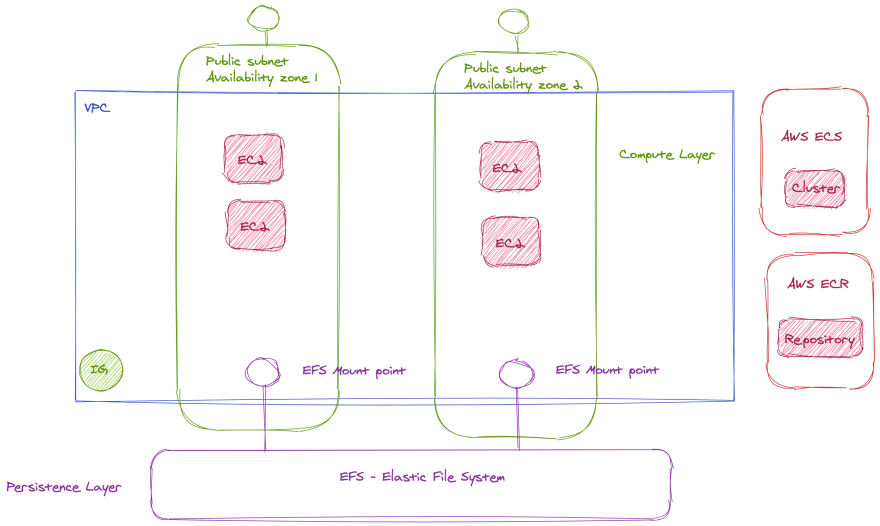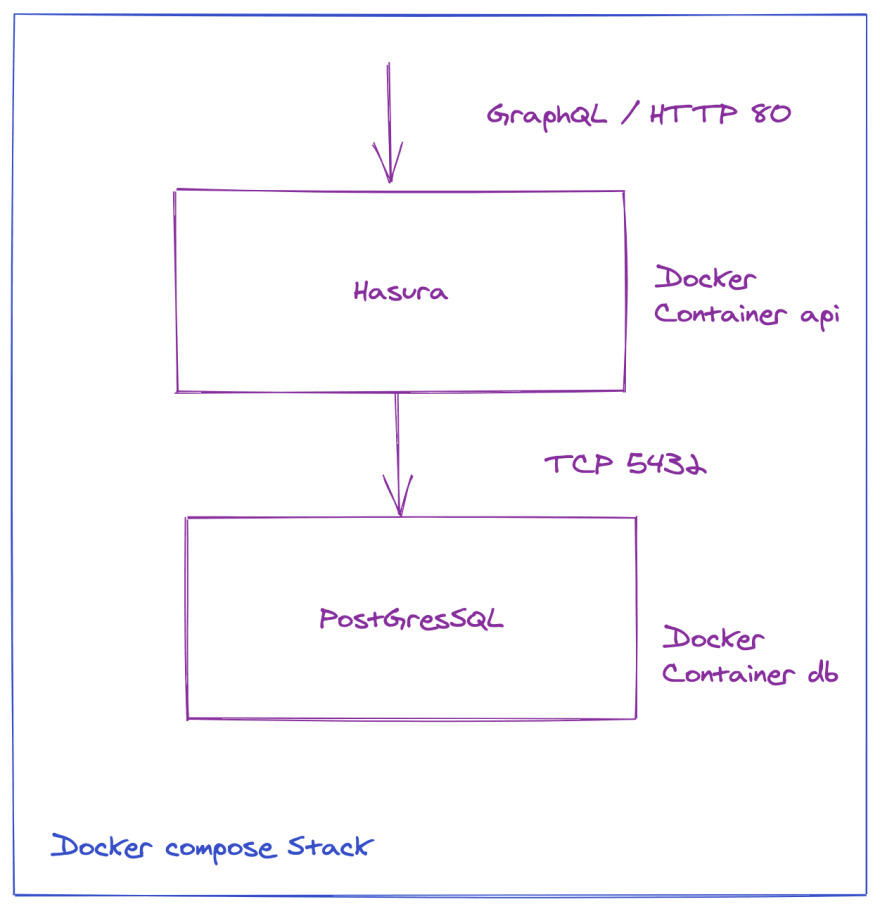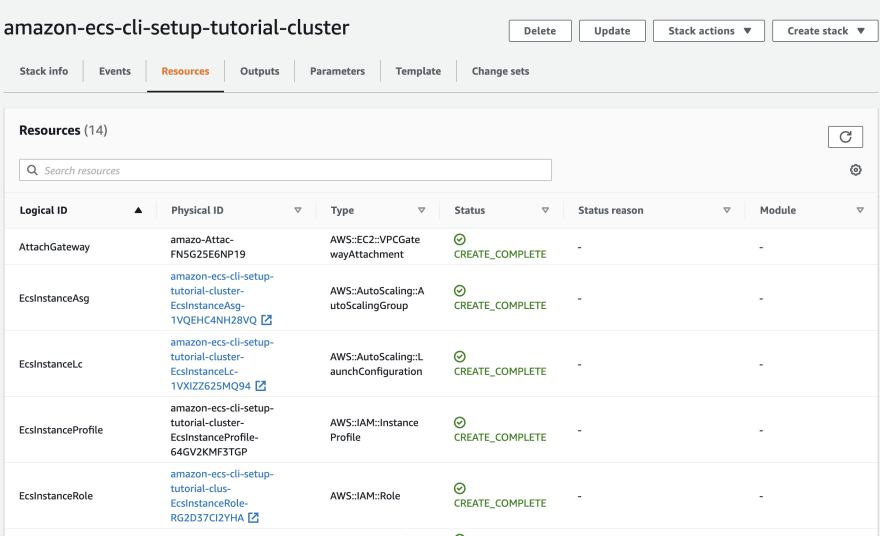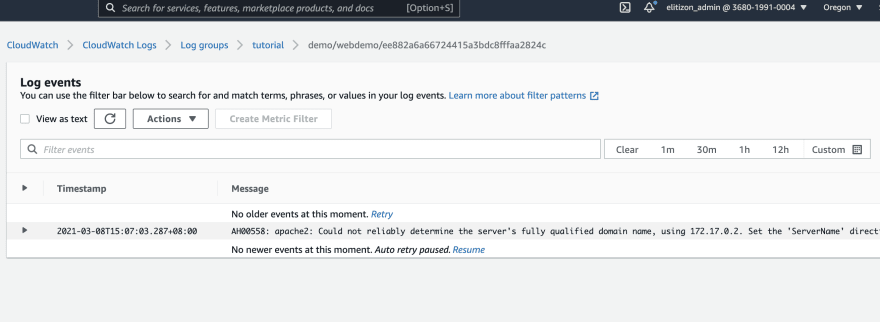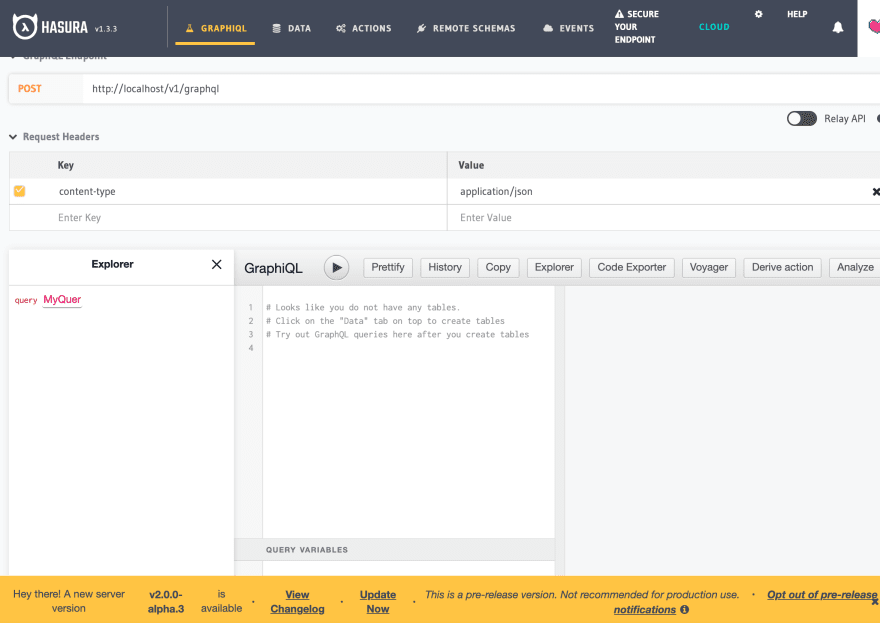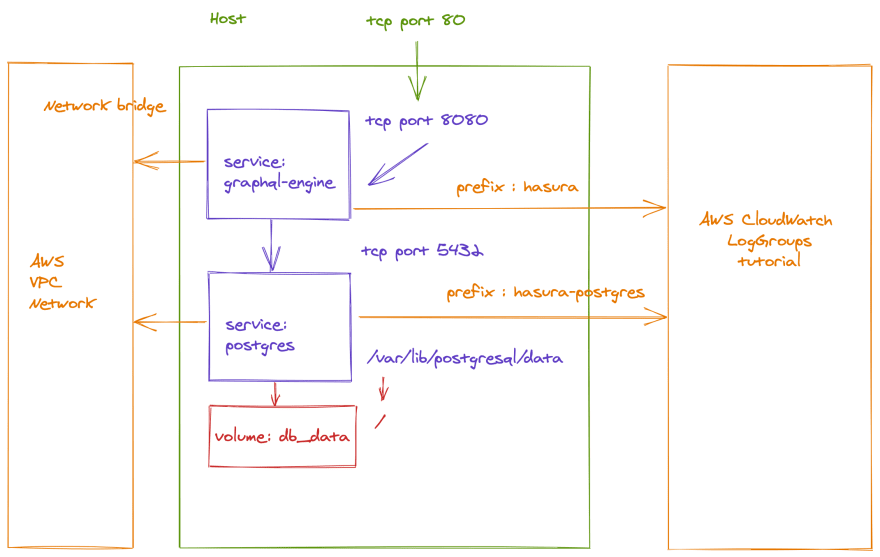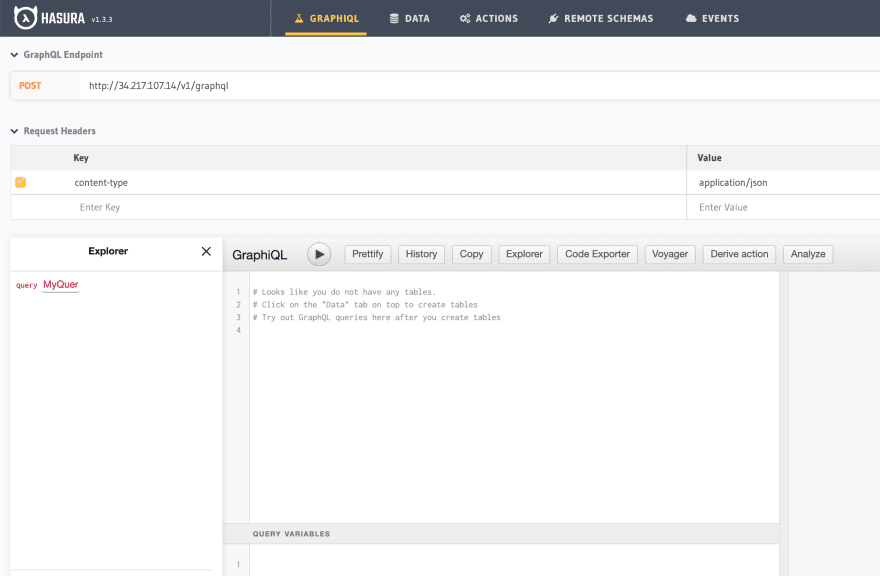An Interest In:
Web News this Week
- April 18, 2024
- April 17, 2024
- April 16, 2024
- April 15, 2024
- April 14, 2024
- April 13, 2024
- April 12, 2024
10 minutes to deploy a Docker compose stack on AWS ECS illustrated with Hasura and Postgres
Introduction
The ecs-cli command is a little gem
ecs-cli allows you to deploy a Docker stack very easily on AWS ECS using the same syntax as the docker-compose file format version 1, 2 and 3
The selling point of ecs-cli is to reuse your docker-compose.yml files to deploy your containers to AWS
ecs-cli translates a docker-compose-yml to ECS Task Desfinitions and Services
In this article we will explore how to:
- Use the tool
ecs-clito create an AWS ECS cluster to orchestrate a set of Docker Containers - Add observability to the cluster thanks to AWS Cloud LogGroups
- Use ecs-cli to deploy a set of Docker containers on the Cluster
- Leverage AWS EFS to add persistence to the Cluster and add support of stateful workloads
Amazon Elastic File System is a cloud storage service provided by Amazon Web Services designed to provide scalable, elastic, concurrent with some restrictions, and encrypted file storage for use with both AWS cloud services and on-premises resources
As an example we will deploy a Docker stack composed of:
- HASURA : an open source-engine that gives you an instant GraphQL & Rest API
- PostgresSQL 13.2 for the persistence layer
Target architecture
Docker stack
This Docker Stack will be deployed on the AWS ECS Cluster
7 Steps
- Install
ecs-cli - Configure
ecs-cli - Create the cluster Stack
- Create a
Docker Compose Stack - Deploy the docker compose stack on
AWS ECS - Create an elastic filesystem
AWS EFS - Add persistence to Postgres SQL thanks to
AWS EFS
Prerequisites (for macOS)
Step1 : Install ecs-cli
The first step is to install the ecs-cli command on your system:
The complete installation procedure for macOS, Linux and Windows is available with this link.
For macOS the installation procedure is as follows:
Download ecs-cli binary
sudo curl -Lo /usr/local/bin/ecs-cli https://amazon-ecs-cli.s3.amazonaws.com/ecs-cli-darwin-amd64-latest install gnupg (a free implementation of OpenPGP standard)
brew install gnupg get the public key of ecs-cli (I have copied the key in a GIST for simplicity)
https://gist.githubusercontent.com/raphaelmansuy/5aab3c9e6c03e532e9dcf6c97c78b4ff/raw/f39b4df58833f09eb381700a6a854b1adfea482e/ecs-cli-signature-key.key import the signature
gpg --import ./signature.key make ecs-cli executable
sudo chmod +x /usr/local/bin/ecs-cli verify the setup
ecs-cli --version Configure ecs-cli
Prerequisite
- AWS CLI v2 must be installed. If it's not the case you can follow these instructions on this link.
- You need to have an AWS_ACCESS_KEY_ID / AWS_SECRET_ACCESS_KEY with administrative privileges
To create your AWS_ACCESS_KEY_ID you can read this documentation
Your environment variables must be configured with a correct pair of AWS_ACCESS_KEY_ID / AWS_SECRET_ACCESS_KEY
export AWS_ACCESS_KEY_ID="Your Access Key"export AWS_SECRET_ACCESS_KEY="Your Secret Access Key"export AWS_DEFAULT_REGION=us-west-2The following script configure an ECS-profile called tutorial for a cluster named tutorial-cluster on the us-west-2 region with a default launch type based on EC2 instances:
configure.sh
#!/bin/bashset -ePROFILE_NAME=tutorialCLUSTER_NAME=tutorial-clusterREGION=us-west-2LAUNCH_TYPE=EC2ecs-cli configure profile --profile-name "$PROFILE_NAME" --access-key "$AWS_ACCESS_KEY_ID" --secret-key "$AWS_SECRET_ACCESS_KEY"ecs-cli configure --cluster "$CLUSTER_NAME" --default-launch-type "$LAUNCH_TYPE" --region "$REGION" --config-name "$PROFILE_NAME"Step2 : Creation of an ECS-Cluster
We will create an ECS-Cluster based on ec2 instance.
ECS allows 2 launch types EC2 and FARGATE
- EC2 (Deploy and manage your own cluster of EC2 instances for running the containers)
- AWS Fargate (Run containers directly, without any EC2 instances)
If we want to connect to the ec2 instances with ssh we need to have a key pair
Creation of a key pair called tutorial-cluster :
aws ec2 create-key-pair --key-name tutorial-cluster \ --query 'KeyMaterial' --output text > ~/.ssh/tutorial-cluster.pem Creation of the Cluster tutorial-cluster with 2 ec2-instances t3.medium
create-cluster.sh
#!/bin/bashKEY_PAIR=tutorial-cluster ecs-cli up \ --keypair $KEY_PAIR \ --capability-iam \ --size 2 \ --instance-type t3.medium \ --tags project=tutorial-cluster,owner=raphael \ --cluster-config tutorial \ --ecs-profile tutorialWe have added 2 tags project=tutorial and owner=raphael to easily identify the resources created by the command
Result
INFO[0006] Using recommended Amazon Linux 2 AMI with ECS Agent 1.50.2 and Docker version 19.03.13-ceINFO[0007] Created cluster cluster=tutorial-cluster region=us-west-2INFO[0010] Waiting for your cluster resources to be created...INFO[0010] Cloudformation stack status stackStatus=CREATE_IN_PROGRESSINFO[0073] Cloudformation stack status stackStatus=CREATE_IN_PROGRESSINFO[0136] Cloudformation stack status stackStatus=CREATE_IN_PROGRESSVPC created: vpc-XXXXXSecurity Group created: sg-XXXXXSubnet created: subnet-AAAASubnet created: subnet-BBBBCluster creation succeeded.This command create:
- A new public VPC
- An internet gateway
- The routing tables
- 2 public subnets in 2 availability zones
- 1 security group
- 1 autoscaling group
- 2 ec2 instances
- 1 ecs cluster
We can now deploy a sample Docker application on the newly created ECS Cluster:
Create a file called docker-compose.yml
version: "3"services: webdemo: image: "amazon/amazon-ecs-sample" ports: - "80:80"This stack can best tested locally
docker-compose upResults:
latest: Pulling from amazon/amazon-ecs-sample
Digest: sha256:36c7b282abd0186e01419f2e58743e1bf635808231049bbc9d77e59e3a8e4914
Status: Downloaded newer image for amazon/amazon-ecs-sample:latest
We can now deploy this stack on AWS ECS:
ecs-cli compose --project-name tutorial --file docker-compose.yml \--debug service up \--deployment-max-percent 100 --deployment-min-healthy-percent 0 \--region us-west-2 --ecs-profile tutorial --cluster-config tutorial To verify that the service is running we can use this command:
ecs-cli psResults:
Name State Ports TaskDefinition Healthtutorial-cluster/2e5af2d48dbc41c1a98/webdemo RUNNING 34.217.107.14:80->80/tcp tutorial:2 UNKNOWNKThe stack is deployed and accessible with the IP address 34.217.107.14
We can now browse the deployed Website:
open http://34.217.107.14 Open the port 22 to connect to the EC2 instances of the cluster
# Get my IPmyip="$(dig +short myip.opendns.com @resolver1.opendns.com)"# Get the security groupsg="$(aws ec2 describe-security-groups --filters Name=tag:project,Values=tutorial-cluster | jq '.SecurityGroups[].GroupId')"# Add port 22 to the Security Group of the VPCaws ec2 authorize-security-group-ingress \ --group-id $sg \ --protocol tcp \ --port 22 \ --cidr "$myip/32" | jq '.' Connection to the instance
chmod 400 ~/.ssh/tutorial-cluster.pemssh -i ~/.ssh/tutorial-cluster.pem [email protected] Once we are connected to the remoter server: we can observe the running containers:
docker psCONTAINER ID IMAGE COMMAND CREATED STATUS PORTS NAMES7deaa49ed72c amazon/amazon-ecs-sample "/usr/sbin/apache2 -" 2 minutes ago Up 2 minutes 0.0.0.0:80->80/tcp ecs-tutorial-3-webdemo-9cb1a49483a9cfb7b101cd1d2a9807d4 amazon/amazon-ecs-agent:latest "/agent" 55 minutes ago Up 55 minutes (healthy) ecs-agentStep3 : Adding observability
If we want to collect the logs for my running instances, we can create AWS CloudWatch Log Groups.
For that we can modify the docker-compose.yml file:
version: "2"services: webdemo: image: "amazon/amazon-ecs-sample" ports: - "80:80" logging: driver: awslogs options: awslogs-group: tutorial awslogs-region: us-west-2 awslogs-stream-prefix: demo And then redeploy the service with a create-log-groups option
ecs-cli compose --project-name tutorial --file docker-compose.yml \--debug service up \--deployment-max-percent 100 --deployment-min-healthy-percent 0 \--region us-west-2 --ecs-profile tutorial --cluster-config tutorial \--create-log-groups We can now delete the service
ecs-cli compose --project-name tutorial --file docker-compose.yml \--debug service down \--region us-west-2 --ecs-profile tutorial --cluster-config tutorialDeploying a more complex stack
We are now ready to deploy HASURA and Postgres
docker-compose.yml
version: '3'services: postgres: image: postgres:12 restart: always volumes: - db_data:/var/lib/postgresql/data environment: POSTGRES_PASSWORD: postgrespassword graphql-engine: image: hasura/graphql-engine:v1.3.3 ports: - "80:8080" depends_on: - "postgres" restart: always environment: HASURA_GRAPHQL_DATABASE_URL: postgres://postgres:postgrespassword@postgres:5432/postgres ## enable the console served by server HASURA_GRAPHQL_ENABLE_CONSOLE: "true" # set to "false" to disable console ## enable debugging mode. It is recommended to disable this in production HASURA_GRAPHQL_DEV_MODE: "true" HASURA_GRAPHQL_ENABLED_LOG_TYPES: startup, http-log, webhook-log, websocket-log, query-log ## uncomment next line to set an admin secret # HASURA_GRAPHQL_ADMIN_SECRET: myadminsecretkeyvolumes: db_data: We can test the stack locally:
docker-compose up &Then
open localhostWe can now deploy this stack on AWS ECS
But before that we need to update the file docker-compose.yml
We must add:
- A
loggingdirective - A
linksdirective
version: '3'services: postgres: image: postgres:12 restart: always volumes: - db_data:/var/lib/postgresql/data environment: POSTGRES_PASSWORD: postgrespassword logging: driver: awslogs options: awslogs-group: tutorial awslogs-region: us-west-2 awslogs-stream-prefix: hasura-postgres graphql-engine: image: hasura/graphql-engine:v1.3.3 ports: - "80:8080" depends_on: - "postgres" links: - postgres restart: always environment: HASURA_GRAPHQL_DATABASE_URL: postgres://postgres:postgrespassword@postgres:5432/postgres ## enable the console served by server HASURA_GRAPHQL_ENABLE_CONSOLE: "true" # set to "false" to disable console ## enable debugging mode. It is recommended to disable this in production HASURA_GRAPHQL_DEV_MODE: "true" HASURA_GRAPHQL_ENABLED_LOG_TYPES: startup, http-log, webhook-log, websocket-log, query-log ## uncomment next line to set an admin secret # HASURA_GRAPHQL_ADMIN_SECRET: myadminsecretkey logging: driver: awslogs options: awslogs-group: tutorial awslogs-region: us-west-2 awslogs-stream-prefix: hasuravolumes: db_data:We need to create a file called ecs-params.yml to specify extra parameters:
version: 1task_definition: ecs_network_mode: bridgeThis file will be used by the ecs-cli command.
we can then launch the stack:
ecs-cli compose --project-name tutorial --file docker-compose.yml \ --debug service up \--deployment-max-percent 100 --deployment-min-healthy-percent 0 \ --region us-west-2 --ecs-profile tutorial \--cluster-config tutorial --create-log-groupsResults:
DEBU[0000] Parsing the compose yaml...DEBU[0000] Docker Compose version found: 3DEBU[0000] Parsing v3 project...WARN[0000] Skipping unsupported YAML option for service... option name=restart service name=postgresWARN[0000] Skipping unsupported YAML option for service... option name=depends_on service name=graphql-engineWARN[0000] Skipping unsupported YAML option for service... option name=restart service name=graphql-engineDEBU[0000] Parsing the ecs-params yaml...DEBU[0000] Parsing the ecs-registry-creds yaml...DEBU[0000] Transforming yaml to task definition...DEBU[0004] Finding task definition in cache or creating if needed TaskDefinition="{
ContainerDefinitions: [{
Command: [],
Cpu: 0,
DnsSearchDomains: [],
DnsServers: [],
DockerSecurityOptions: [],
EntryPoint: [],
Environment: [{
Name: \"POSTGRES_PASSWORD\",
Value: \"postgrespassword\"
}],
Essential: true,
ExtraHosts: [],
Image: \"postgres:12\",
Links: [],
LinuxParameters: {
Capabilities: {
},
Devices: []
},
Memory: 512,
MountPoints: [{
ContainerPath: \"/var/lib/postgresql/data\",
ReadOnly: false,
SourceVolume: \"db_data\"
}],
Name: \"postgres\",
Privileged: false,
PseudoTerminal: false,
ReadonlyRootFilesystem: false
},{
Command: [],
Cpu: 0,
DnsSearchDomains: [],
DnsServers: [],
DockerSecurityOptions: [],
EntryPoint: [],
Environment: [
{
Name: \"HASURA_GRAPHQL_ENABLED_LOG_TYPES\",
Value: \"startup, http-log, webhook-log, websocket-log, query-log\"
},
{
Name: \"HASURA_GRAPHQL_DATABASE_URL\",
Value: \"postgres://postgres:postgrespassword@postgres:5432/postgres\"
},
{
Name: \"HASURA_GRAPHQL_ENABLE_CONSOLE\",
Value: \"true\"
},
{
Name: \"HASURA_GRAPHQL_DEV_MODE\",
Value: \"true\"
}
],
Essential: true,
ExtraHosts: [],
Image: \"hasura/graphql-engine:v1.3.3\",
Links: [],
LinuxParameters: {
Capabilities: {
},
Devices: []
},
Memory: 512,
Name: \"graphql-engine\",
PortMappings: [{
ContainerPort: 8080,
HostPort: 80,
Protocol: \"tcp\"
}],
Privileged: false,
PseudoTerminal: false,
ReadonlyRootFilesystem: false
}],
Cpu: \"\",
ExecutionRoleArn: \"\",
Family: \"tutorial\",
Memory: \"\",
NetworkMode: \"\",
RequiresCompatibilities: [\"EC2\"],
TaskRoleArn: \"\",
Volumes: [{
Name: \"db_data\"
}]
}"DEBU[0005] cache miss taskDef="{
}" taskDefHash=4e57f367846e8f3546dd07eadc605490INFO[0005] Using ECS task definition TaskDefinition="tutorial:4"WARN[0005] No log groups to create; no containers use 'awslogs'INFO[0005] Updated the ECS service with a new task definition. Old containers will be stopped automatically, and replaced with new ones deployment-max-percent=100 deployment-min-healthy-percent=0 desiredCount=1 force-deployment=false service=tutorialINFO[0006] Service status desiredCount=1 runningCount=1 serviceName=tutorialINFO[0027] Service status desiredCount=1 runningCount=0 serviceName=tutorialINFO[0027] (service tutorial) has stopped 1 running tasks: (task ee882a6a66724415a3bdc8fffaa2824c). timestamp="2021-03-08 07:30:33 +0000 UTC"INFO[0037] (service tutorial) has started 1 tasks: (task a1068efe89614812a3243521c0d30847). timestamp="2021-03-08 07:30:43 +0000 UTC"INFO[0074] (service tutorial) has started 1 tasks: (task 1949af75ac5a4e749dfedcb89321fd67). timestamp="2021-03-08 07:31:23 +0000 UTC"INFO[0080] Service status desiredCount=1 runningCount=1 serviceName=tutorialINFO[0080] ECS Service has reached a stable state desiredCount=1 runningCount=1 serviceName=tutorial And then we can verify that our container are running on AWS ECS Cluster
ecs-cli psResults
Name State Ports TaskDefinition Healthtutorial-cluster/00d7ff5191dd4d11a9b52ea64fb9ee26/graphql-engine RUNNING 34.217.107.14:80->8080/tcp tutorial:10 UNKNOWNtutorial-cluster/00d7ff5191dd4d11a9b52ea64fb9ee26/postgres RUNNING tutorial:10 UNKNOWN And then:
open http://34.217.107.14 We can now stop the stack
ecs-cli compose downTo add persistent support to my solution we can leverage AWS EFS : Elastic File System
Step 4: Add a persistent layer to my cluster
Create an EFS file system named hasura-db-file-system
aws efs create-file-system \ --performance-mode generalPurpose \ --throughput-mode bursting \ --encrypted \ --tags Key=Name,Value=hasura-db-filesystemResults:
{ "OwnerId": "XXXXX", "CreationToken": "10f91a50-0649-442d-b4ad-2ce67f1546bf", "FileSystemId": "fs-5574bd52", "FileSystemArn": "arn:aws:elasticfilesystem:us-west-2:XXXXX:file-system/fs-5574bd52", "CreationTime": "2021-03-08T16:40:19+08:00", "LifeCycleState": "creating", "Name": "hasura-db-filesystem", "NumberOfMountTargets": 0, "SizeInBytes": { "Value": 0, "ValueInIA": 0, "ValueInStandard": 0 }, "PerformanceMode": "generalPurpose", "Encrypted": true, "KmsKeyId": "arn:aws:kms:us-west-2:XXXXX:key/97542264-cc64-42f9-954e-4af2b17f72aa", "ThroughputMode": "bursting", "Tags": [ { "Key": "Name", "Value": "hasura-db-filesystem" } ]} Add mount points to each subnet of the VPC:
aws ec2 describe-subnets --filters Name=tag:project,Values=tutorial-cluster \ | jq ".Subnets[].SubnetId" | \xargs -ISUBNET aws efs create-mount-target \ --file-system-id fs-5574bd52 --subnet-id SUBNETThe next step is to allow NFS connection from the VPC
We need first to get the security group associated with each mount target
efs_sg=$(aws efs describe-mount-targets --file-system-id fs-5574bd52 \ | jq ".MountTargets[0].MountTargetId" \ | xargs -IMOUNTG aws efs describe-mount-target-security-groups \ --mount-target-id MOUNTG | jq ".SecurityGroups[0]" | xargs echo ) Then we need to open the TCP port 2049 for the security group of the VPC
vpc_sg="$(aws ec2 describe-security-groups \ --filters Name=tag:project,Values=tutorial-cluster \ | jq '.SecurityGroups[].GroupId' | xargs echo)" Then we need to authorize the TCP/2049 port from the default security group of the VPC
aws ec2 authorize-security-group-ingress \--group-id $efs_sg \--protocol tcp \--port 2049 \--source-group $vpc_sg \--region us-west-2 We can now modify the ecs-params.yml to add persistence support:
- We use the ID of the EFS volume that has been created on the latest step :
fs-5574bd52
version: 1task_definition: ecs_network_mode: bridge efs_volumes: - name: db_data filesystem_id: fs-5574bd52 transit_encryption: ENABLED Then we can redeploy our stack:
ecs-cli compose --project-name tutorial --file docker-compose.yml \ --debug service up \--deployment-max-percent 100 --deployment-min-healthy-percent 0 \ --region us-west-2 --ecs-profile tutorial \--cluster-config tutorial --create-log-groupsEt voil : the stack is operational
Summary
We have deployed an ECS-CLI Cluster and launched a docker compose stack
The next step will be to expose and secure the stack using an AWS Application Load Balancer
The scripts associated with this article is available at
https://github.com/raphaelmansuy/using-ecs-cli-tutorial-01.git
Original Link: https://dev.to/raphaelmansuy/10-minutes-to-deploy-a-docker-compose-stack-on-aws-illustrated-with-hasura-and-postgres-3f6e
Dev To
 An online community for sharing and discovering great ideas, having debates, and making friends
An online community for sharing and discovering great ideas, having debates, and making friendsMore About this Source Visit Dev To


